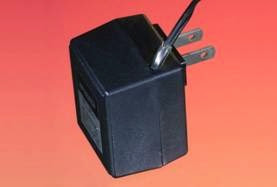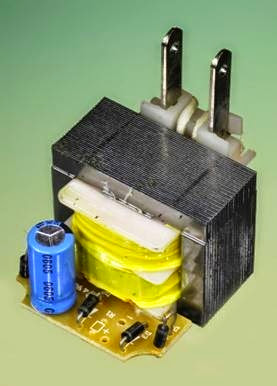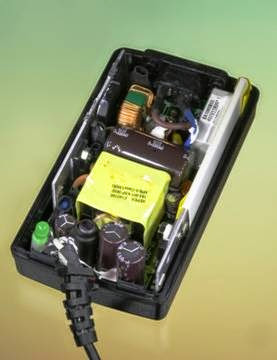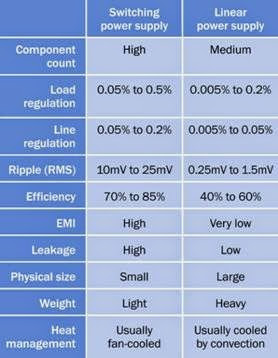Also known as an AC adapter. When packaged as a palm-sized plastic package that plugs directly into a power outlet, it is occasionally known colloquially as a wall-wart.
What It Does
An AC-DC power supply converts alternating cur rent (AC) into the direct current (DC) that most electronic devices require, usually at a lower volt age. Thus, despite its name, a power supply actually requires an external supply of power to operate.
Larger products, such as computers or stereo equipment, generally have a power supply contained within the device, enabling it to plug directly into a wall outlet. Smaller battery-powered devices, such as cellular phones or media players, generally use an external power supply in the form of a small plastic pod or box that plugs into a wall outlet and delivers DC via a wire terminating in a miniature connector. The external type of power supply is often, but not always, referred to as an AC adapter.
Although an AC-DC power supply is not a single component, it is often sold as a preassembled modular unit from component suppliers.
Variants
The two primary variants are a linear regulated power supply and switching power supply.
Linear Regulated Power Supply
A linear regulated power supply converts AC to DC in three stages:
1. A power transformer reduces the AC input to lower-voltage AC.
2. A rectifier converts the AC to unsmoothed DC. Rectifiers are discussed in the entry on diodes in this encyclopedia.
3. A voltage regulator, in conjunction with one or more capacitors, controls the DC voltage, smooths it, and removes transients. The regulator is properly known as a linear voltage regulator because it contains one or more transistors, which are functioning in linear mode—that is, responding linearly to fluctuations in base current, at less than their saturation level. The linear voltage regulator gives the linear regulated power supply its name.
A simplified schematic of a linear regulated power supply is shown in Figure 16-1.
This type of power supply may be described as transformer-based, since its first stage consists of a transformer to drop the AC input voltage before it is rectified.
Figure 16-1. A basic linear regulated power supply.
Because the rectifier in a power supply generally passes each pulse of AC through a pair of silicon diodes, it will impose a voltage drop of about 1.2V at peak current. A smoothing capacitor will drop the voltage by about 3V as it removes ripple from the current, whereas a voltage regulator typically requires a difference of at least 2V be tween its input and its output. Bearing in mind also that the AC input voltage may fluctuate be low its rated level, the output from the power transformer should be at least 8VAC higher than the ultimate desired DC output. This excess power will be dissipated as heat.
The basic principle of the linear regulated power supply originated in the early days of electronic devices such as radio receivers. A transistorized version of this type of power supply remained in widespread use through the 1990s. Switching power supplies then became an increasingly at tractive option as the cost of semiconductors and their assembly decreased, and high-voltage transistors became available, allowing the circuit to run directly from rectified line voltage with no step-down power transformer required.
Some external AC adapters are still transformer- based, but are becoming a minority, easily identified by their relatively greater bulk and weight. An example is shown in Figure 16-2.
Figure 16-3 shows the handful of components inside a cheap, relatively old AC adapter. The out
Figure 16-2. A simple transformer-based power supply can be encapsulated in a plastic shell, ready to plug into a power outlet. However, today this format more typically contains a switching power supply, which is usually light- er, smaller, and cheaper.
put from a power transformer is connected di rectly to four diodes (the small black cylinders), which are wired as a full-wave rectifier. A single electrolytic capacitor provides some smoothing, but because there is no voltage regulator, the output will vary widely depending on the load. This type of AC adapter is not suitable for powering any sensitive electronic equipment.
Switching Power Supply
Also known as a switched-mode power supply, an SMPS, or switcher, it converts AC to DC in two stages.
1. A rectifier changes the AC input to un smoothed DC, without a power transformer.
2. A DC-DC converter switches the DC on and off at a very high frequency using pulse- width modulation to reduce its average effective voltage. Often the converter will be the flyback type, containing a transformer, but the high-frequency switching allows the transformer to be much smaller than the power transformer required in a linear regulated power supply. See the DC-DC converter entry in this encyclopedia for an ex planation of the working principles.
Figure 16-3. A relatively old, cheap AC adapter contains only the most rudimentary set of components, and does not supply the kind of properly regulated DC power re- quired by electronic equipment.
A simplified schematic of a switching power sup ply is shown in Figure 16-4.
The interior of a relatively early switching power supply designed to deliver 12VDC at up to 4A is shown in Figure 16-5. This supply generated considerable waste heat, necessitating well-spaced components and a ventilated enclosure.
The type of small switching power supply that is now almost universally used to power laptop computers is shown in Figure 16-6. Note the smaller enclosure and the higher component count than in the older power supply shown in Figure 16-5. The modern unit also delivers considerably more power, and generates less waste heat. Although this example is rated at 5A, the
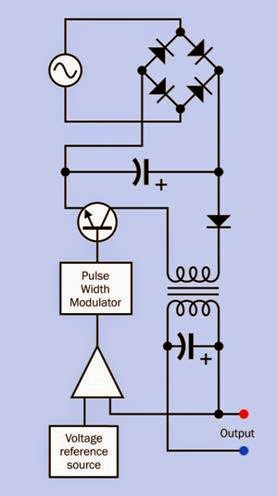 Figure 16-4. Greatly simplified schematic showing the principal components of a switching power supply. Note the absence of a 115VAC power transformer. The trans- former that is inserted subsequently in the circuit functions in conjunction with the high switching frequency, which allows it to be very much smaller, cheaper, and lighter.
Figure 16-4. Greatly simplified schematic showing the principal components of a switching power supply. Note the absence of a 115VAC power transformer. The trans- former that is inserted subsequently in the circuit functions in conjunction with the high switching frequency, which allows it to be very much smaller, cheaper, and lighter.
transformer (hidden under the yellow wrapper at the center of the unit) is smaller than the power transformer that would have been found in an old-style AC adapter delivering just 500mA.
The modern power supply is completely sealed, where earlier versions required ventilation. On
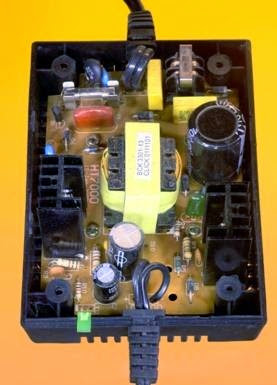 Figure 16-5. The interior of an early switching power sup- ply.
Figure 16-5. The interior of an early switching power sup- ply.
the downside, the plastic case of the switching supply requires a metal liner (removed for this photograph) to contain high-frequency electro magnetic radiation.
Unregulated Power Supply
Typically this consists of a transformer and rectifying diodes with little or no smoothing or volt age control of the output.
Adjustable Power Supply
This is usually a linear power supply incorporating an adjustable voltage regulator. This type of supply has laboratory applications and is found as a benchtop item to power electronics design projects during their development.
Figure 16-6. The interior of the type of switching power supply that powers a laptop computer.
Voltage Multiplier
Devices such as photocopiers and laser printers, televisions, cathode-ray tubes, and microwave ovens require voltages significantly higher than those supplied by domestic AC power outlets. A voltage multiplier usually contains a step-up transformer followed by DC conversion components, but detailed consideration is outside the scope of this encyclopedia.
Formats
An open frame power supply consists of components on a circuit board, usually mounted on a metal chassis, with no enclosure or fan cooling.
A covered power supply is enclosed in a protective perforated metal box with a cooling fan if needed. Power supplies sold for desktop computers are usually in this format.
Power supplies are also available in rack-mount and DIN-rail formats.
How to Use it
Because a switching power supply contains no power transformer, it is lighter and smaller, and may be cheaper than a linear power supply. It is also more efficient and generates less waste heat. These advantages have made switching power supplies the most popular option to provide DC power for electronics devices. However, the high- frequency switching tends to create electromagnetic interference (EMI), which must be filtered to protect the output of the device and also to minimize the risk of this interference feeding back into AC power wiring. The high-frequency switched power may also generate harmonics, which must be suppressed.
High-quality linear regulated power supplies still find application in laboratory equipment, low- noise signal processing, and other niches where excellent regulation and low-ripple output are necessary. They are relatively heavy, bulky, and inefficient.
See Figure 16-7 for a chart comparing the ad vantages and disadvantages of linear and switching power supplies.
What Can Go Wrong
High Voltage Shock
One or more capacitors in a power supply may retain a relatively high voltage for some time after the unit has been unplugged. If the power supply is opened for inspection or repairs, cau tion is necessary when touching components.
Capacitor Failure
If electrolytic capacitors fail in a switching power supply (as a result of manufacturing defects, dis use, or age), allowing straight-through conduction of alternating current, the high-frequency switching semiconductor can also fail, allowing
input voltage to be coupled unexpectedly to the output. Capacitor failure is also a potential problem in linear power supplies. For additional in formation on capacitor failure modes, see Chap ter 12.
Figure 16-7. Comparison of attributes of linear regulated power supplies and switching power supplies. (Adapted from Acopian Technical Company.)
Electrical Noise
If electrolytic capacitors are used, their gradual deterioration over time will permit more electrical noise associated with high-frequency switch ing in a switching power supply.
Peak Inrush
A switching power supply allows an initial inrush or surge of current as its capacitors accumulate their charge. This can affect other components in the circuit, and requires fusing that tolerates brief but large deviations from normal power consumption.


